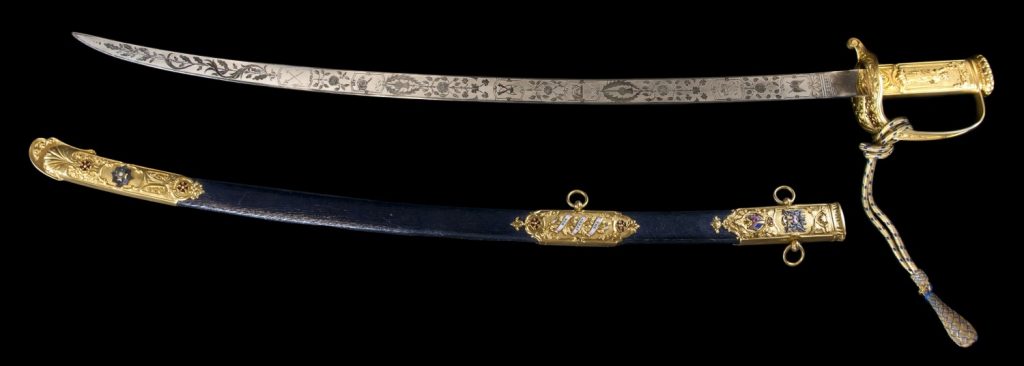
Your willingness to wrestle with your demons will cause your angels to sing.
— August Wilson
Radio Golf Paperback
Joe Turner’s Come and Gone

Your willingness to wrestle with your demons will cause your angels to sing.
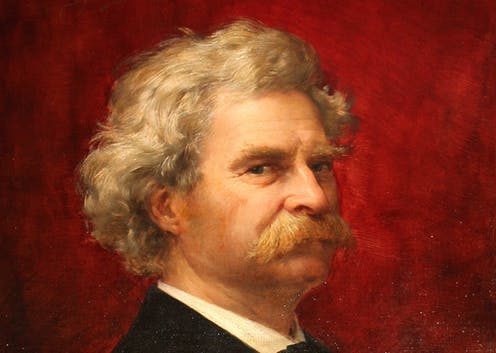
Twenty years from now you will be more disappointed by the things you didn’t do. So throw off the bowlines. Sail away from the safe harbor. Catch the trade winds in your sails.
EXPLORE. DREAM. DISCOVER.
-Mark Twain
The Old Guard Recruiting
October 2020
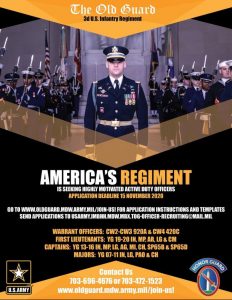
The Old Guard -3d Infantry Regiment is the oldest infantry regiment in the US ARMY with origins beginning in 1784.
21 September is the annual day when the command comes together to celebrate the beginnings and history of the regiment. Families and veterans would also join in the activities at Fort Myer This year the activities are impacted by the virus outbreak. so let’s look at some flashback material. Hopefully, next year, 2021 the annual celebration will resume as normal.
Here is the first flashback from 1963 … a ceremony held on Summerall Field
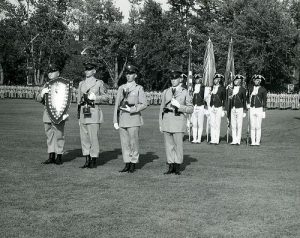
The recipients of rifle qualification awards stand at attention during the Organization Day Parade and Ceremonies of the 1st Battalion (Reinf), 3rd Infantry Regiment (The Old Guard), held on Summerall Field, Fort Myer, Virginia.. . They are from left to right: First Sergeant Melvin G. Richardson, representing D Co. for highest average qualification score, Specialist 4 Stanley W. Neisten, 1st Place. Private First Class Otha L. Calhoun, 2nd Place. Specialist 4 Stanley J. Saccomen, 3rd Place. . Photo by Specialist 4 Walter D. Clark, MDW Signal Support Unit, Picture Division, US Army. September 20, 1963.. . The large trophy is the Fennessy Trophy, named for Corporal a member of the Regiment killed at the annual shooting matches at Camp Perry, Ohio, in 1913.
In 1935, the regiment was back at Fort Snelling which was considered at that time “their home” station. There was a regimental band. The organization day was held on 21 September. Among the activities for the day were a band concert, kittenball, potato race, and the traditional tug of war.
Images of America – Fort Myer is a pictorial chronicle of the first one hundred years of history containing over two hundred photographs, maps, and images.
Beginning in the 1860s and carrying through the 1960s it provides a view of what was over time.
An autographed copy of the book can be purchased at BUY THE BOOK.

Our American Flag has an interesting evolution over the years since the first design which is known as the “Betsy Ross” flag up until the current 50 stars and thirteen stripes.
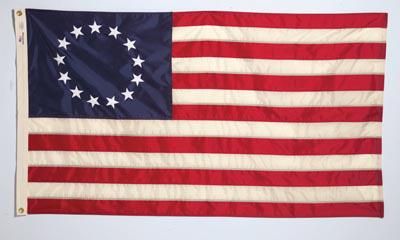
Although it is not a proven factual event, legend has it that Betsy Ross sewed the first American Flag from a pencil sketch drawn by George Washington. While it is true that Ross was an acquaintance of George Washington and sewed many American flags throughout her life, there is no evidence to support the claims of her descendants that she did in fact create the first American Flag at the request of George Washington.
On September 14, 1814, Francis Scott Key, a lawyer, was detained on a British ship in Baltimore Harbor. Onboard to negotiate the release of some American prisoners, he watched as the night before the British flotilla bombarded Fort McHenry to force the submission and surrender of the fort. Yet when dawn broke, the 15-starred and 15-striped American flag known as the Star-Spangled Banner was still flying over the fort,
Francis Scott Key was so moved by the sight, he penned the four stanzas of what has become America’s national anthem.
Oh, say can you see by the dawn’s early light
What so proudly we hailed at the twilight’s last gleaming?
Whose broad stripes and bright stars thru the perilous fight,
O’er the ramparts we watched were so gallantly streaming?
And the rocket’s red glare, the bombs bursting in air,
Gave proof through the night that our flag was still there.
Oh, say does that star-spangled banner yet wave
O’er the land of the free and the home of the brave?
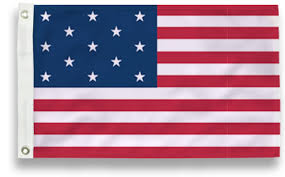
On June 14, 1777, the Second Continental Congress passed The Flag Resolution which stated: “It is resolved that the flag of the United States be made of thirteen stripes, alternated red and white; that the union be thirteen stars, white in a blue field, representing a new Constellation.” For this reason, we now celebrate Flag Day every June 14th. This official original American Flag had 13 stripes and 13 stars to represent the original 13 colonies which included: Delaware, Pennsylvania, New Jersey, Georgia, Connecticut, Massachusetts, Maryland, South Carolina, New Hampshire, Virginia, New York, North Carolina, and Rhode Island.
On the shore, dimly seen through the mists of the deep,
Where the foe’s haughty host in dread silence reposes,
What is that which the breeze, o’er the towering steep,
As it fitfully blows, half conceals, half discloses?
Now it catches the gleam of the morning’s first beam,
In full glory reflected now shines in the stream:
‘Tis the star-spangled banner! Oh long may it wave
O’er the land of the free and the home of the brave!
In 1794, the Flag Act authorized a new 15-star and 15-stripe flag. This regulation went into effect on May 1st, 1795, and the Star-Spangled Banner became the new official flag of the United States. The two additional stars and stripes were added to the original design in order to represent the admission of Vermont (1791) and Kentucky (1792).
This particular edition of the American Flag is known as the Star-Spangled Banner because it was the actual flag that flew over Fort McHenry and served as the inspiration for Francis Scott Key’s song that would become the national anthem, “Star-Spangled Banner”, of The United States of America
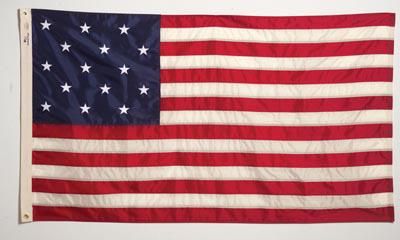
And where is that band who so vauntingly swore
That the havoc of war and the battle’s confusion,
A home and a country should leave us no more!
Their blood has washed out their foul footsteps’ pollution.
No refuge could save the hireling and slave
From the terror of flight, or the gloom of the grave:
And the star-spangled banner in triumph doth wave
O’er the land of the free and the home of the brave!
This 48-star flag became the official American Flag on July 4th, 1912. Two stars were added for the admission of New Mexico (1912) and Arizona (1912) to the United States of America.
Oh! thus be it ever, when freemen shall stand
Between their loved home and the war’s desolation!
Blest with victory and peace, may the heav’n rescued land
Praise the Power that hath made and preserved us a nation.
Then conquer we must, when our cause it is just,
And this be our motto: “In God is our trust.”
And the star-spangled banner in triumph shall wave
O’er the land of the free and the home of the brave!
This 50-star flag became the official American Flag on July 4th, 1960. A star was added for the state of Hawaii, which was admitted to the United States of America on August 21st, 1959.

Fort McHenry aerial view
Defenders’ Day — It’s Baltimore’s oldest holiday celebrated with military participation … imagine the giant 30 x 42-foot Star-Spangled Banner flag being raised over Fort McHenry as the wind catches it. The fifteen stars and fifteen stripes of the flag flying over the fort as it has every day since the night that the British bombarded the fort. It was during the war of 1812 that sixteen British ships approached Fort McHenry, and in the early morning of September 13, 1814, they began a 25-hour bombardment of the fort.
As dawn broke the British hopes of bombing the Americans into submission were dashed. Flying over the fort was the star-spangled banner – the valiant soldiers in the fort persisted and defended the city of Baltimore.
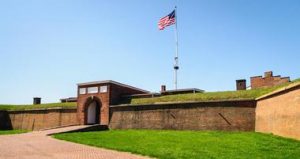
Fort McHenry Sally Port
Francis Scott Key was aboard one of the British ships and upon seeing the waving flag over the fort inspired him to write the four stanzas of what has become the United States of America’s National Anthem.
This year, 2020, because of health considerations, this historic site which is a national monument has been closed to the public. However, with the assistance of the Old Guard – the 3d Infantry Regiment and the US Army Field Band, a virtual celebration is presented.
Also, the park rangers of the National Park Service and Soldiers from the Old Guard raised the Star-Spangled Banner the 30′ by 42′ flag over Fort McHenry.
A few years ago John Michael finally was able to visit Fort McHenry. Previous attempts were unsuccessful. However, early one Sunday morning, he along with William S Connery – “The History Guy” traveled from Alexandria to this outstanding fort. Bypassing the video wall in the visitors’ center, the two of them made a beeline to the fort and its interior. It was just in time to witness and participate in the raising of the Star-Spangled Banner. The feeling of holding a piece of history as it was raised up the flagpole was one that is totally unforgettable.
Bill Connery, like John Michael, is a published author of two books:

|
|
|
|
|
|
Images of America – Fort Myer is a pictorial chronicle of the first one hundred years of history containing over two hundred photographs, maps, and images. Beginning in the 1860s and carrying through the 1960s it provides a view of what was over time. An autographed copy of the book can be purchased at BUY THE BOOK.

|
The Tomb of the Unknown Soldier is a monument dedicated to deceased U.S. service members whose remains have not been identified. It is located in Arlington National Cemetery in Virginia, United States.

OCT. 25, 2019 |
Courtesy of the U.S. Department of Defense
“The appearance of the U.S. Department of Defense (DoD) visual information does not imply or constitute DoD endorsement.”
At 100, Jack Eaton is the oldest living, oldest known sentinel of the Tomb of the Unknown Soldier. His and other sentinels’ names are there on plaques, commemorating their service. Sentinels, all volunteers, are members of the 3rd U.S. Infantry Regiment, also known as “The Old Guard.”
Life in the Army for Eaton began when he left coal country in southeastern Pennsylvania to enlist in 1937 at age 18. Stationed at Fort Belvoir, Virginia, he said, he fired expert with his rifle and was very competitive in military training and other activities, and that got him selected for the job. Sentinels are also usually tall, and Eaton’s height also helped. At 6-feet, he was considered tall at the time.
Eaton spoke during a tour of the Pentagon, where he met with Deputy Defense Secretary David L. Norquist and others.
Earlier in the day, he also visited the Tomb of the Unknown Soldier, after arriving on an Honor Flight from Burton, Michigan, where he now lives.
While at the Tomb of the Unknown Soldier in Arlington National Cemetery in Virginia, Eaton said he was struck by the elaborate, precision movements of the sentinels, although he remembers it being similar during his time there, with knife-edge creases on the soldiers’ uniforms. He recalls the snap and pop sounds of doing the manual of arms with his rifle.
One thing that has changed since Eaton’s days as a sentinel is that the changing of the guard ceremony is now every hour instead of every two hours. Eaton said he was told that the change was made so more visitors could view the ceremony, and he said that’s a good thing for the public to see.
Eaton picked up rank quickly and eventually became corporal of the guard, responsible for ensuring that the changing of the guard and other activities went smoothly.
Eaton’s enlistment expired in 1940, and he went to work for Hudson Motor Car Company. His work there was short-lived, however, because the United States entered World War II after the Dec. 7, 1941, attack on Pearl Harbor, Hawaii.
Eager to get into the war, Eaton returned to Fort Belvoir. His old unit had disbanded, but his old company commander was still there and remembered him. He got Eaton into welding school in Washington, where he trained daily on the use of oxy-acetylene and various forms of electric welding. The training soon paid off, he said.
There is no gallery selected or the gallery was deleted.
Eaton was assigned a truck full of welding gear and mechanical tools and parts, as well as a full-time mechanic. In 1942, just months after the war started, Eaton, his mechanic, and the truck were shipped off to England, where they went from airfield to airfield repairing heavy equipment such as bulldozers, graders, and cranes used to build runways.
It was a lot of work, he said because many new runways were being built. This required a lot of heavy equipment, which frequently broke down.
As the war progressed, Eaton, his truck, and his partner were transferred to France, and eventually to Germany. By the end of the war, he had attained the rank of technician fourth grade.
After the war ended in 1945, Eaton said, he went back to Hudson to work, but only for a short time, because he found a better job in the window replacement industry.
After a while, he said, he decided he could make a lot more money starting up his own window business, and he did so after purchasing a 2,100-square-foot factory and showroom. His business was such a success that he was able to retire at the ripe young age of 55.
Eaton said he’s impressed with the service members he meets today. As for advice to give them on how to succeed, he offered: “Accept responsibility, don’t shirk your duty, honor your oath, be proud of what you do, and try to do better each time.” He also said that healthy competition with other soldiers will do much toward self-improvement.
As for his secret to living to be 100 and walking around the Pentagon at a fast pace without a wheelchair, Eaton credited the genes of his mother, who lived to be 100. He also said he quit smoking in his early 30s, drinks moderately — or not at all for long periods of time — eats right, and gets up every morning to do rigorous exercises.
Eaton said he’s lived a full and happy life and was blessed to have the chance to serve his country and contribute to society afterward.
Images of America – Fort Myer is a pictorial chronicle of the first one hundred years of history containing over two hundred photographs, maps, and images. Beginning in the 1860s and carrying through the 1960s it provides a view of what was over time.
of what was over time.
An autographed copy of the book can be purchased at BUY THE BOOK.
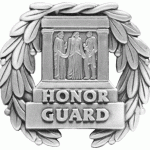
Guard Identification Badge Tomb of the Unknown Soldier
The tomb guards are soldiers of the United States Army. The first military guards were troopers from the 3rd Cavalry, “Brave Rifles”, who were posted nearby on Fort Myer. Since April 6, 1948, (known then as “Army Day“), when the regiment was reactivated, it has been guarded by soldiers from the 3rd Infantry Regiment, “The Old Guard”. The Old Guard is also posted to Fort Myer, Virginia, adjacent to Arlington National Cemetery.
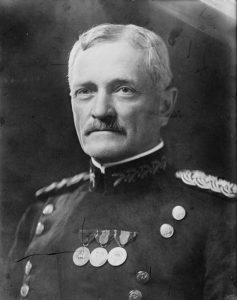
GENERAL JOHN J PERSHING
ONE HUNDRED YEARS AGO TODAY
Congress, HOUSE OF REPRESENTATIVES. Session No. 308. Thanks of the AMERICAN PEOPLE TO GEN. JOHN J. PERSHING. September 11, 1919. — Committed to the Committee of the Whole House on the state of the Union and ordered to be printed. Mr. Kahn, from the Committee on Military Affairs, submitted the following REPORT.
[To accompany H. J. Res. 202.] The Committee on Military Affairs, to who has referred the resolution (H. J. Res. 202) tendering the thanks of the American people and the Congress of the United States to Gen. John J Pershing and to the officers and men of the American Expeditionary Forces, and for other purposes, having considered the same, report thereon make a recommendation that it do pass. Congress has on a number of occasions authorized the presentation of swords or medals to officers of the Army and Navy. In the case of Admiral Dewey, a sword was presented. Gen. Grant received a medal. In view of the high honors conferred by Great Britain, France, Italy, and the other allied nations upon their commanding generals, your committee thought it would be exceedingly appropriate to present Gen. Pershing with the sword for which appropriation is made in the joint resolution. The resolution also expresses the thanks of the American people and of Congress to Gen. Pershing and to the officers and men under his command.
P
